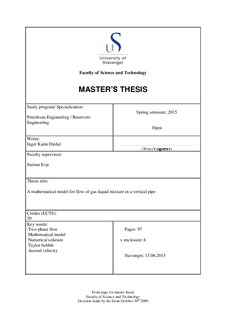| dc.contributor.author | Dirdal, Inger Karin | |
| dc.date.accessioned | 2015-09-22T10:40:22Z | |
| dc.date.available | 2015-09-22T10:40:22Z | |
| dc.date.issued | 2015-06-15 | |
| dc.identifier.uri | http://hdl.handle.net/11250/301120 | |
| dc.description | Master's thesis in Petroleum engineering | nb_NO |
| dc.description.abstract | A one-dimensional mathematical model for the ascend velocity to a Taylor bubble consisting of gas in a two-phase flow of gas and liquid in vertical pipes is derived.
This model illustrates different effects of two-phase flow in pipes from a numerical approach. The model is based on the conservation laws of mass and momentum for an initial gas slug located on the closed of bottom in a pipe which is filled with stagnant liquid.
The model is investigated at laboratory scale where assumptions as incompressible fluids, no viscosity terms, no acceleration effects and equal phase pressure are made.
The derivation lead to an expression of the superficial velocity of liquid depending on the liquid volume fraction (alpha_l), gravitational acceleration (g), density difference between liquid and gas (Delta rho) and friction between fluids and wall (f_g and f_l) as well as interfacial tension (C).
The numerical solutions are found by implementing the derived model of the superficial liquid velocity into a MATLAB script for computing the solution. The numerical solutions is compared with an experimental case in addition to previous research on ascending Taylor bubbles of gas in pipes with liquid.
The model corresponds well with results from previous experiments and observations made during performance of experiments.
It gives a good estimation of the ascend velocity of the Taylor bubble, pressure, differential pressure and illustrate the characteristic nose shape of the Taylor bubble.
The numerical solution is seen to be sensitive to how the friction terms are defined.
The model also responds well with the result from previous research regarding the velocity of the ascending Taylor bubble independence of the gas layers length and shows good response on changes in interfacial tension. | nb_NO |
| dc.language.iso | eng | nb_NO |
| dc.publisher | University of Stavanger, Norway | nb_NO |
| dc.relation.ispartofseries | Masteroppgave/UIS-TN-IPT/2015; | |
| dc.rights | Navngivelse 3.0 Norge | * |
| dc.rights.uri | http://creativecommons.org/licenses/by/3.0/no/ | * |
| dc.subject | petroleumsteknologi | nb_NO |
| dc.subject | petroleum engineering | nb_NO |
| dc.subject | Taylor bubble | nb_NO |
| dc.subject | reservoir engineering | nb_NO |
| dc.subject | two-phase flow | nb_NO |
| dc.subject | mathematical model | nb_NO |
| dc.subject | numerical solution | nb_NO |
| dc.subject | ascend velocity | nb_NO |
| dc.title | A mathematical model for flow of gas-liquid mixture in a vertical pipe | nb_NO |
| dc.type | Master thesis | nb_NO |
| dc.subject.nsi | VDP::Technology: 500::Rock and petroleum disciplines: 510::Petroleum engineering: 512 | nb_NO |

